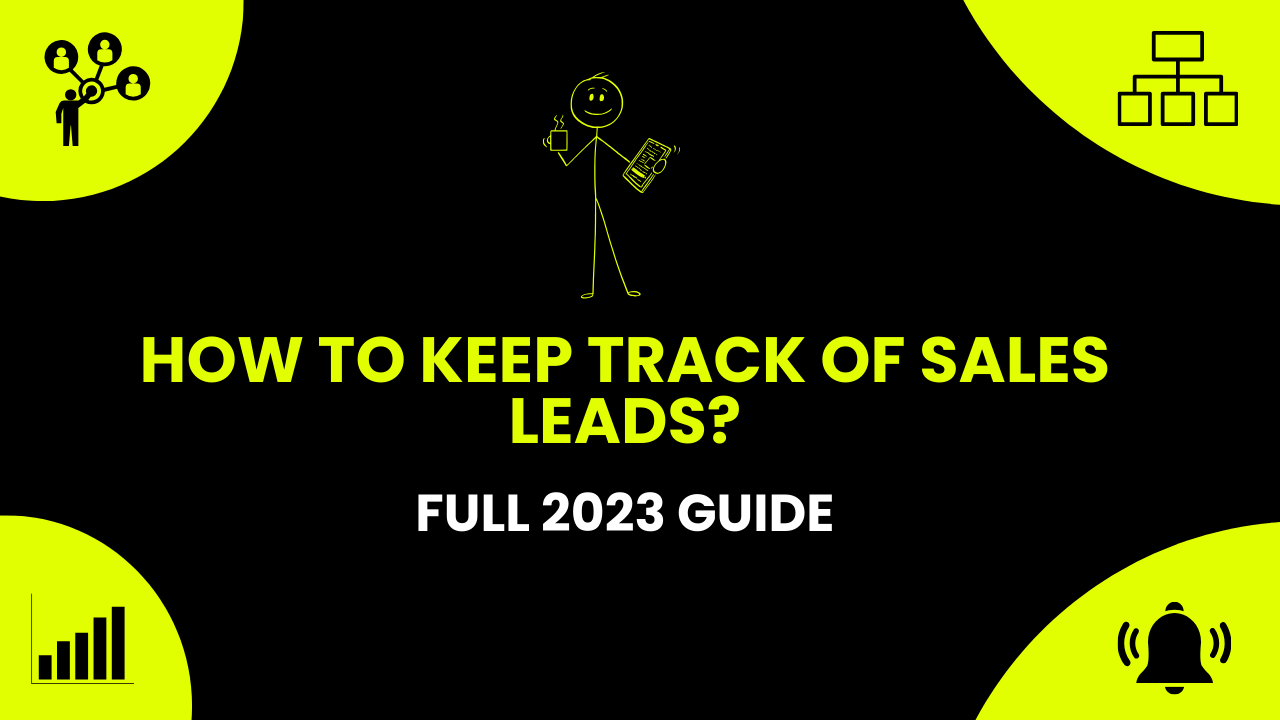Imagine two salespeople in the heart of New York City.
The first, John, sits in a dimly lit office, his desk a chaotic landscape of post-its, scribbled notes, and coffee-stained lists.
Each morning, he sifts through this jumble, trying to remember who he spoke to last, which lead seemed promising, and which ones had gone cold.
The constant juggle leaves him exhausted, often missing golden opportunities hidden amidst the clutter.
Across the street, there’s Lisa.
Her workspace is the polar opposite: clean, organized, and digital.
She has a system in place, a method to her madness.
Each lead is meticulously tracked, from the first point of contact to the final handshake.
She knows exactly who to call, when, and most importantly, why.
Her leads aren’t just names on a list; they’re potential stories waiting to unfold.
Who do you think closes more deals?
Exactly!
It’s a simple truth: organization and strategy can make or break a sales process.
Mastering lead generation is one thing, ensuring those leads convert is another.
The bridge between these two?
Keeping track of every sales lead as soon as they step into your world.
Dive in with us, and let’s uncover the power of effective lead tracking and its pivotal role in business success.
Summary
In this blog, we’ll illuminate the art and science of sales leads tracking.
From understanding its core essence to the compelling reasons for its importance, we’ll guide you through effective strategies to optimize your lead management and positively impact your pipeline.
Additionally, we’ll highlight common pitfalls to avoid and share exclusive tips from ZeroIn to elevate your tracking game.
Whether you’re a novice or a seasoned pro, this guide promises insights that can transform your sales approach.
Dive in!
What is Sales Leads Tracking
Sales leads tracking is the systematic process of monitoring and recording every interaction and activity related to a lead or potential customer, from the initial point of contact until they convert into a paying customer – or decide not to.
Why is Sales Leads Tracking Important?

In the dynamic world of sales and marketing, information is power and every interaction with a potential customer is a goldmine of insights waiting to be tapped.
Sales leads tracking isn’t just a logistical necessity – it’s the backbone of a successful marketing and sales strategy.
By keeping a close eye on each lead’s journey, you can glean a deeper understanding of your audience’s needs, preferences, and pain points.
This knowledge, in turn, shapes more effective marketing campaigns, fine-tunes sales pitches, and fosters genuine relationships with potential clients.
Without effective tracking, you risk flying blind, missing out on opportunities, and misallocating resources, ultimately affecting your pipeline’s efficiency.
In essence, sales leads tracking is the compass that guides businesses to their true north: converting potential into profit.
Curious about the tangible benefits?
Let’s take a look at specifics.
Why should you Track your Sales Leads?
In the bustling arena of business, every department is a cog in a larger machine.
Marketing teams are constantly crafting marketing strategies, churning out content, and ensuring it lands in front of the right eyes.
Sales teams?
They’re in the trenches, connecting, persuading, and sealing deals.
With all these moving parts, you might pause and ask: Is tracking every sales lead truly essential?
Let’s cut to the chase.
Tracking sales leads isn’t just a good-to-have – it’s a must-have. And here’s why:
Reason #1 Optimization of Sales Strategy
Think of your sales strategy as a roadmap.
Now, if you’re driving without knowing where you’ve been or where you’re headed, you’ll likely end up lost, wasting fuel and time.
Tracking sales leads is like having a GPS for your sales journey.
It provides real-time feedback, showing which routes (or strategies) are getting you to your destination faster and which detours are costing you.
By understanding the behavior and preferences of your leads, you can fine-tune your approach, ensuring that every move is calculated, every pitch is personalized, and every resource is utilized to its maximum potential.
In essence, tracking leads allows you to optimize your sales strategy, ensuring you’re always on the fastest route to success
Reason #2 Enhanced Organizational Efficiency
Efficiency isn’t just about speed – it’s about making every action count.
So when you track sales leads, you’re not just collecting data, you’re streamlining processes.
Knowing the status of each lead means less time spent on guesswork and more time on actionable steps.
No more redundant follow-ups or shooting in the dark.
Instead, your team can focus on what they do best: engaging with leads at the right time with the right message.
This not only boosts productivity but also ensures that every team member is aligned, working harmoniously towards a common goal.
The result?
A well-oiled machine where every cog, big or small, plays a pivotal role in driving growth.
Reason #3 Precision Targeting
Not all leads are the same.
Some are red-hot, ready to seal the deal, while others are just dipping their toes in the water, gauging if it’s the right fit.
Without tracking, treating every lead identically can be like using a sledgehammer where a scalpel is needed.
Precision targeting, made possible through meticulous lead tracking, allows you to discern which leads are ripe for the picking and which ones need a bit more nurturing.
By understanding the nuances of each lead, you can tailor your approach, ensuring you go all in when the iron is hot and take a gentler, more indirect route when needed. Speaking of which…
Reason #4 Tailored Lead Nurturing
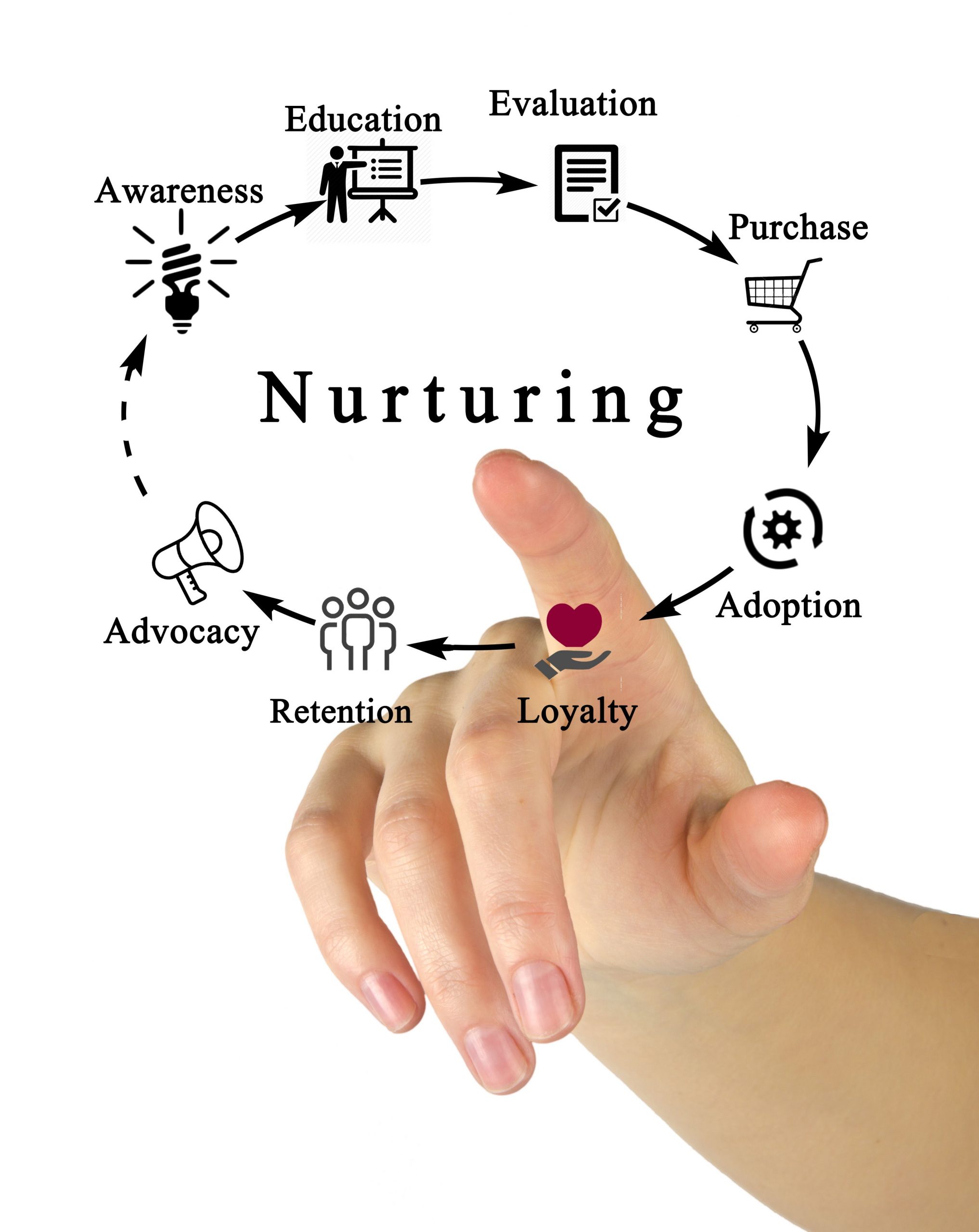
Not every lead is ready to buy immediately. As we touched on earlier, some require a bit more attention and care.
Now, the whole point of “lead nurturing” is to guide potential clients through the decision-making process, providing them with the right information at the right time, with the hopes they’ll eventually convert into actual clients.
So by tracking sales leads, you’ll gain insights into their unique needs and concerns which will allow you to send targeted messages, offer solutions to their specific problems, and build trust over time.
As you already know, it’s not about bombarding them with sales pitches, but about understanding and addressing their individual journey.
In doing so, you not only increase the likelihood of a sale but also foster a relationship that can lead to long-term loyalty and higher lifetime value.
Reason #5 Data-Driven Decision Making
In today’s cutthroat business environment, relying solely on gut feelings or intuition is a gamble few can afford. The importance of effective management of data cannot be overstated.
The modern playbook demands data at its core, and CRM tools are instrumental in facilitating this.
By using CRM to keep track of sales leads, you’re not just collecting numbers; you’re gathering invaluable insights into market trends, lead behaviors, and the efficacy of your marketing campaigns. The management of this data, using CRM, can make all the difference in understanding your audience and their preferences.
Adopting a data-driven stance ensures that every pivotal decision, whether it’s allocating marketing budget, refining your sales pitch, or strategizing your CRM approaches, is anchored in solid evidence.
This not only minimizes potential pitfalls but also amplifies the chances of achieving stellar returns.
In essence, with data at your fingertips and a robust CRM software in place, you’re playing the business game with an ace up your sleeve.
How to Keep Track of Your Sales Leads Effectively?
Alright, so you understand the importance of tracking sales leads.
But how do you actually go about it in a way that’s both efficient and effective?
It’s not just about scribbling names on a notepad or dumping contacts into a spreadsheet.
It’s about a systematic approach, one that evolves with your business and the ever-changing landscape of sales.
Let’s dive into the nitty-gritty, the actionable steps that can transform your lead management from haphazard to top-notch.
Ready to elevate your game?
Let’s get started.
Way #1 Understand the Buying Journey
Every customer embarks on a journey before making a purchase, often referred to as a funnel.
It’s a path filled with questions, considerations, and decisions. This path is segmented into different stages, each vital in steering the customer’s decision.
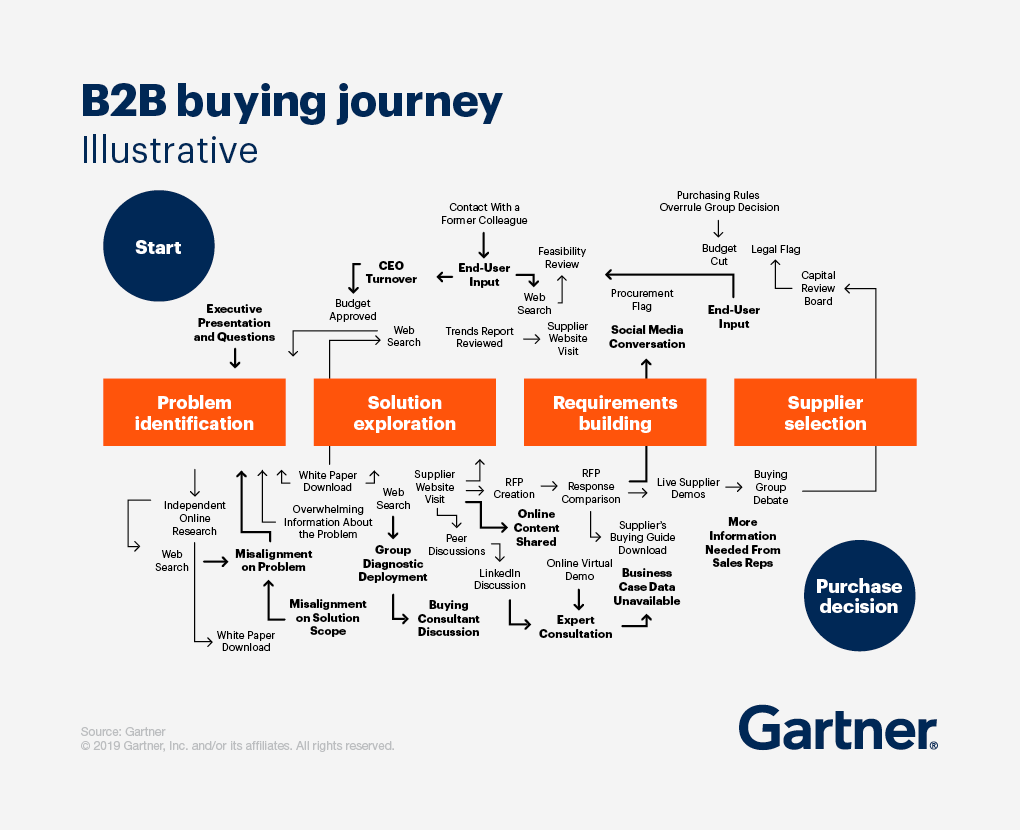
By understanding this buying journey, or funnel, you position yourself to be there at every pivotal stage.
It’s not just about knowing when they’re ready to buy, but also recognizing when they’re seeking information, comparing options, or even having second thoughts.
By mapping out and understanding this journey, you can tailor your interactions, ensuring you provide value at each stage of the funnel.
It’s like having a conversation where you always know the right thing to say because you truly understand where they’re coming from and which stage they’re at.
And in sales, that deep understanding of both the funnel and its stages can make all the difference.
Way #2 Use Lead Scoring
Not all leads are created equal.
Some are on the brink of making a purchase, while others are just casually browsing.
Treating them all the same can be a recipe for inefficiency and missed opportunities.
That’s where lead scoring comes into play.
Lead scoring is a systematic method of assigning values, or scores, to each lead based on specific criteria to determine how likely is for the lead to become a customer.
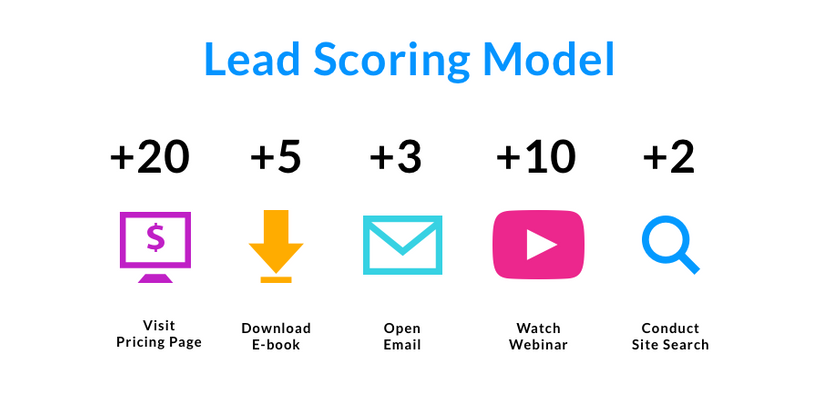
These criteria can include their interaction with your website, response to marketing initiatives, demographic information, and more.
The higher the score, the closer the lead is to conversion.
This prioritization ensures that efforts are directed towards leads with the highest propensity to buy, optimizing both time and resources.
Way #3 Use Lead Tracking Software
In today’s fast-paced digital landscape relying on manual methods to track leads is like trying to catch rain with a sieve… it’s inefficient and you’re bound to miss a lot.
To truly elevate your sales performance, you need tools designed for the task.
Lead tracking software is your answer.
It serves as a comprehensive platform, capturing every interaction, every detail, and every nuance of your leads.
With this software, you’re not just collecting data, you’re gaining a holistic view of how each prospect engages with your brand.
But it doesn’t stop at mere data collection.
These tools provide actionable insights, pinpointing where your leads originate, their behavior with your content, and the triggers that push them toward conversion.
Armed with this knowledge, you can fine-tune lead scoring, segment with precision, and craft communication that truly resonates.
Way #4 Segment Your Leads
Imagine walking into a room and speaking to a diverse crowd – from teenagers to retirees, tech enthusiasts to technophobes. If you use the same pitch for everyone, you’ll likely miss the mark for most.
The same principle applies to your leads and how you manage them in your pipeline.
Lead segmentation is the art of categorizing your leads based on shared characteristics, behaviors, or interests. It’s about understanding that while every lead is valuable, they’re not all the same.And just as you would manage a diverse crowd with tailored pitches, the management of leads requires an equally nuanced approach.
By segmenting your leads, you can tailor your messaging to resonate with each group’s unique needs and pain points. Whether it’s by industry, purchase history, or interaction with your content, segmentation allows for a more personalized approach. Incorporating efficient management strategies and a streamlined pipeline ensures that no lead is overlooked.
The result?
Instead of a one-size-fits-all strategy, you have targeted marketing campaigns that speak directly to the heart of each segment. And by optimizing both your management techniques and pipeline processes, you further enhance your chances of success.
In sales, this tailored approach isn’t just a nice touch – it’s the bridge to meaningful connections and lasting business relationships
Way #5 Regularly Update and Clean Your Lead Database
The world of sales is ever-evolving, and so are your leads.
What was relevant a month ago might not hold water today.
Just as you wouldn’t rely on an outdated map to navigate a city, you shouldn’t lean on stale data to guide your sales efforts.
Regularly updating and cleaning your lead database is akin to spring cleaning for your sales strategy.
It ensures that you’re working with fresh, accurate information.
Management of your sales resources is crucial, and a part of that involves meticulous management of your lead data.
Outdated contacts, incorrect details, or prospects that have gone cold can clutter your database, making it harder to focus on the prospects that truly matter.
By routinely pruning and updating your database, you ensure that every lead you engage with is a genuine opportunity, not a dead end.
This not only optimizes your lead generation efforts but also ensures that your messaging remains relevant and impactful.
After all, in the realm of business, precision, relevance, and efficient management are the cornerstones of lasting success.
Way #6 Use Analytics and Reporting
In the vast sea of sales and marketing, data is your guiding star. But raw data, in isolation, can be overwhelming and, frankly, a bit meaningless. That’s where CRM tools, with their advanced analytics and reporting, come into play.
Using analytics within a CRM means diving deep into your data, extracting patterns, insights, and actionable intelligence.
It’s about understanding not just the ‘what’ but also the ‘why’ behind every lead interaction. CRM systems provide invaluable support in deciphering these interactions.
Did a particular marketing campaign resonate well? Why did a certain demographic respond more positively?
CRM analytics provides the answers.
Reporting, on the other hand, is about presenting these insights in a digestible format. It’s your sales story, told through numbers, charts, and graphs within your CRM.
A well-structured report can highlight successes, pinpoint areas of improvement, and guide future marketing and sales management strategies.
Incorporating analytics and reporting into your lead tracking process ensures you’re not just collecting data, but harnessing it. With CRM software at the forefront, it’s the roadmap that turns raw data into strategic action, driving you closer to your sales goals.
Way #7 Foster Strong Communication Within Your Team
Effective lead tracking goes beyond the software and spreadsheets. At its core, it’s a team sport. And like any team sport, communication is key.
Imagine the harmony of a well-coordinated orchestra, where every instrument plays its part to perfection.
That’s the kind of synergy you want between your sales and marketing deparmants.
When both departments are in sync, sharing insights, updates, and feedback about leads, the entire lead generation process becomes more streamlined and effective.
This sales and marketing alignment ensures that no lead falls through the cracks.
Whether it’s passing on information about a lead’s preferences or updating the team about a recent interaction, every bit of communication adds value.
In essence, fostering strong communication within your team isn’t just a good-to-have, it’s essential.
It ensures that every lead is given the attention and care they deserve, guiding them seamlessly through their buying journey.
What are common mistakes in Sales Leads Tracking?
Even with the best intentions, businesses can sometimes veer off course when it comes to sales leads tracking. It’s not always about the big, glaring errors – often, it’s the subtle missteps that can throw a wrench in the works.
Recognizing these pitfalls is half the battle.
By understanding where things can go awry, you’re better equipped to steer clear and keep your efforts on point.
Let’s dive into some of these common mistakes, so you can sidestep them and keep your sales engine humming smoothly.
Mistake #1 Not Tracking All Lead Sources
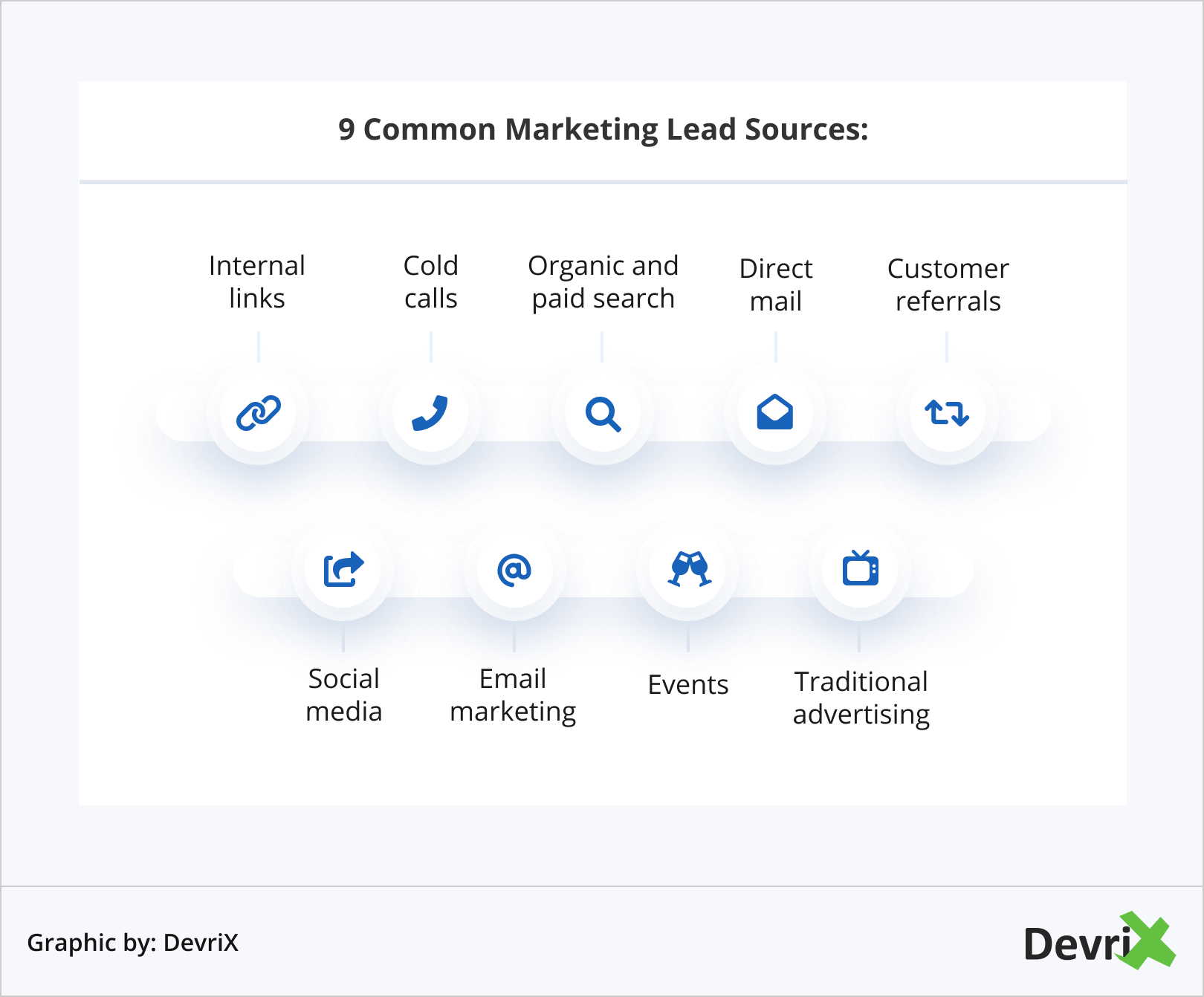
Source: DevriX
Imagine hosting a grand party and forgetting to ask your guests where they heard about it. You’d miss out on knowing which invitations or announcements worked best. Similarly, in the realm of sales, neglecting to track all lead sources is a missed opportunity.
Every lead source, be it a social media marketing campaign, an email blast, or a referral, provides a unique insight into your audience’s behavior. Utilizing CRM effectively can ensure these insights are captured and analyzed systematically. By overlooking even one source, you’re essentially flying blind in that segment of your market.
When you track every source, you gain a comprehensive view of what’s resonating with your audience and what’s not. Harnessing the full potential of your CRM tools can refine your strategies, allowing for better resource allocation and maximized outreach.
In short, if you’re not leveraging your CRM software to keep tabs on all lead sources, you’re not only leaving valuable insights on the table but also potentially impacting the efficiency and success of your pipeline.
Mistake #2 Relying on Outdated or Inaccurate Data
In our data-centric world, the quality of your data is paramount.
Using outdated or inaccurate data is like trying to hit a moving target with a blindfold on – it’s a recipe for misguided strategies and wasted resources.
Many tools out there might promise accurate insights but end up delivering a mix of irrelevant or stale information.
This is where ZeroIn shines.
It doesn’t just provide data – it offers clean, verified, and actionable insights, enriched with business emails checked in real-time.
Boasting a 98% accuracy rate and strict adherence to GDPR standards, ZeroIn ensures businesses steer clear of this all-too-common mistake, arming them with data they can confidently act upon.
Although ZeroIn is primarily an email business finder, it provides you with a lot more than a mere email address:
- First and Second Name: Stand out with personalized user outreach.
- Business Email: Delve into real-time verified emails with up to 98% accuracy and less than 3% email bounces, laying a strong foundation for any outreach strategy.
- Phone Number: Broaden your horizon and engage in versatile communication channels.
- Profession and Job Title: Gain insights into a lead’s profession and job title, enabling informed and genuine interactions tailored to their specific role in the industry.
- Industry: Align your messages to industry norms, ensuring they resonate every time.
- State/Country and ZIP Code: Geographically nuanced marketing, because regional preferences matter.
- Website URL: Gain a 360-degree view of prospects, understanding their digital presence.
- LinkedIn and Twitter: Deepen your understanding and connect with leads on a professional (LinkedIn) and personal level (Twitter).
- Postal Addresses: Embrace the power of multi-channel marketing.
- Company Details: Equip yourself with comprehensive information including company name, address, year founded, employee count, and revenue. This depth of insight ensures your outreach is precise and informed
Mistake #3 Not Nurturing Your Leads
We’ve touched on this before: not all leads are cut from the same cloth.
Some are raring to go, credit card in hand, while others are still weighing their options, perhaps teetering on the edge of a decision.
A common misstep companies make is zeroing in solely on the ‘low-hanging fruit’ – those leads ready to buy now.
In doing so, they inadvertently sideline a significant portion of prospective customers.
Just because a lead isn’t ready to commit today doesn’t mean they’re a lost cause.
They might be a few questions away from being convinced, a piece of information short of making a decision, or a concern away from taking the plunge.
By neglecting to nurture these leads, companies are essentially leaving potential revenue on the table.
Remember, today’s hesitant lead could be tomorrow’s loyal customer.
It’s all about giving them the time, information, and care they need to make that leap.
How to measure your Sales Leads Tracking Success?
Measuring the success of your sales leads tracking isn’t just about counting conversions.
It’s about diving deep into specific Key Performance Indicators (KPIs) that give you a clear picture of your efforts’ effectiveness.
Let’s break down some of the most crucial KPIs:
Conversion Rate: This is the ultimate test of your tracking system. If you monitor and nurture leads effectively, they’ll convert. A high conversion rate indicates that your methods are capturing the right information and that your team is using this data effectively to close deals.
Formula: (Number of Leads Converted / Total Number of Leads) x 100
Lead Source Effectiveness: Successful tracking means knowing where your leads are coming from. This metric helps you identify which channels are most fruitful, allowing you to optimize your efforts for those sources.
Formula: (Number of Leads from a Specific Source / Total Number of Leads) x 100
Time to Conversion: Effective lead tracking isn’t just about quantity but also speed. If you’re capturing the right data and acting on it promptly, leads will convert faster. A shorter time to conversion suggests your tracking provides actionable insights that expedite the sales process.
Lead Response Time: This is a direct reflection of how efficiently your system alerts your team to new leads. A swift response can make the difference between capturing a lead’s interest and losing them to a competitor.
Cost Per Acquisition (CPA): Effective tracking ensures you’re not wasting resources on low-quality leads. A lower CPL indicates that your system is efficiently sieving out high-potential leads.
Formula: Total Campaign Cost / Number of Leads Acquired
ROI of Lead Generation Campaigns: This KPI gives a holistic view of the financial effectiveness of your tracking efforts. A high ROI means your system is not only capturing leads but also ensuring they’re of high quality and likely to convert.
Formula: [(Revenue from Lead Campaign – Cost of the Lead Campaign) / Cost of the Lead Campaign] x 100
Lead-to-Customer Ratio: This metric offers insights into the quality of leads your tracking system is capturing. A lower ratio suggests your tracking is honed in on high-potential leads.
Formula: Total Number of New Customers / Total Number of Leads
Sales-Ready Leads: Your system should be able to distinguish between leads who are ready to buy and those who aren’t. A higher number of sales-ready leads indicates that your system is capturing and categorizing leads effectively.
Sales Team Feedback: This qualitative metric offers a ground-level view of how effective your tracking is. If your sales team finds the data actionable and valuable, it’s a sign of a robust process.
Customer Lifetime Value (CLTV) vs. CAC: This comparison ensures that the leads you’re tracking and acquiring are valuable in the long run. A significantly higher CLTV than CAC suggests that your efforts are focused on high-quality, high-value leads.
In a nutshell, these KPIs are the pulse of your sales lead tracking system. They don’t just offer numbers but provide a narrative on how effectively you’re understanding and engaging with prospective customers.
Additional tips from ZeroIn!
Navigating the world of sales lead tracking can be intricate, but with the right approach, it can yield significant results.
Here are some additional tips to enhance your lead tracking and conversion efforts:
Tip #1 Embrace Automation, But Don’t Over-rely on It
Automation is a powerful ally.
It streamlines processes, reduces human error, and ensures consistency.
But remember, while machines can process data, they can’t replicate the human touch.
Use automation to handle repetitive tasks, but ensure that personal interactions remain genuine and human-centric.
Tip #2 Continuously Educate Your Team
The landscape of sales and marketing is ever-evolving.
Ensure that your team is always up-to-date with the latest trends, tools, and best practices.
Regular training sessions, workshops, and seminars can equip your team with the knowledge and skills they need to effectively track and convert leads.
Remember, an informed team is an effective team.
Tip #3 Monitor and Adjust
No strategy, no matter how foolproof, should be set in stone.
The real magic happens when you monitor your results and adjust accordingly.
Maybe a certain lead source isn’t as effective anymore, or perhaps a new tool offers better insights.
Stay agile, keep an eye on the metrics, and be ready to pivot when necessary.
Conclusion
We began this blog with John and Lisa, two contrasting tales of sales lead management.
Their stories aren’t just anecdotes, they’re a reflection of businesses worldwide.
Some are drowning in disarray, while others thrive in organized precision.
The difference?
How they handle their sales leads.
In our journey through this blog guide, we’ve dissected the essence of sales leads tracking, its undeniable importance, and the strategies that can make it a game-changer for your business.
We’ve also spotlighted the pitfalls that can derail your efforts and shared some exclusive wisdom from ZeroIn.
But remember, knowledge without action is just trivia.
It’s time to roll up those sleeves, declutter that desk, and implement what you’ve learned.
Whether you’re just starting out or looking to refine your approach, the tools and insights shared
here can be your catalyst.
Sales success isn’t just about the numbers; it’s about the stories behind those numbers.
Each lead has a narrative, a potential partnership, a future success story.
It’s up to you to write those chapters.
So, as you step out, armed with knowledge and insights, ask yourself:
Are you a John or a Lisa?
Because the choice, and the potential for success, is entirely in your hands.
What is ZeroIn?
ZeroIn isn’t just another name in the vast sea of email discovery platforms, it’s a revolution.
Picture this: a platform that combines the prowess of email discovery with the finesse of a streamlined CRM. Sleek, intuitive, and comprehensive, ZeroIn stands out as a beacon for those navigating the intricate waters of prospecting.
But there’s more to this story.
ZeroIn isn’t content with just being a browser extension that plays nice with LinkedIn Free or LinkedIn Sales Navigator.
It’s a deep diver, delving into the depths of your search parameters, bringing to the surface a holistic view of your prospective customers from its expansive database.
And here’s the kicker: ZeroIn is meticulous.
Every email address you come across undergoes a rigorous 10-step verification process.
So, every lead you chase?
It’s genuine, and it’s gold.
From importing and re-verifying to exporting leads, ZeroIn becomes more than a tool; it’s your right hand in outreach initiatives.
How Can ZeroIn Help you Grow your Business?
Think of ZeroIn as the wind beneath your business’s wings.
It’s crafted to supercharge your outreach and sales, making the often-daunting task of prospect list-building feel like a breeze.
Whether you’re on the hunt for a single email address or a comprehensive list of a thousand,
ZeroIn is on it, discovering and verifying with unmatched speed and precision.
And with its unique duplicate finder, your CRM software remains pristine, devoid of redundancies, ensuring every ounce of your effort is channeled effectively.
But here’s where it gets even better: ZeroIn is a godsend for small to medium-sized companies.
Those who are on the lookout for a potent yet pocket-friendly email discovery and management solution will find ZeroIn’s lifetime payment deal irresistible.
It’s not just a purchase – it’s an investment.
An investment that promises a cascade of returns.
Harnessing ZeroIn’s prowess means supercharging your lead generation efforts, connecting with the right folks, and setting your business on an upward spiral.
Sign Up for a Free Trial!
FAQs
What is Sales Leads Tracking
Sales leads tracking is the systematic process of monitoring and recording every interaction and activity related to a lead or prospective customer, from the initial point of contact until they convert into a paying customer – or decide not to.
Why is Sales Leads Tracking Important?
Sales leads tracking is the cornerstone of a robust sales strategy, offering invaluable insights into audience needs, preferences, and challenges.
It empowers companies to craft impactful marketing campaigns, refine sales pitches, and build authentic relationships with prospects.
Without it, companies risk missing vital opportunities and inefficiently using resources.
Simply put, it’s the guiding force that turns potential into profit.
Why should you Track your Sales Leads?
In the intricate dance of business, tracking sales leads isn’t just a step – it’s the rhythm that ensures every move is in sync.
Here’s why it’s indispensable:
1. Optimization of Sales Strategy
Tracking leads is your sales GPS, guiding strategies and ensuring every move is calculated and resource-efficient.
2. Enhanced Organizational Efficiency
With lead tracking, you streamline processes, eliminate guesswork, and align team efforts, creating a harmonious growth-driven environment.
3. Precision Targeting
Different leads have different temperatures. Tracking helps discern the hot from the lukewarm, ensuring each lead gets the right attention.
4. Tailored Lead Nurturing
By understanding each lead’s unique journey, tracking allows for targeted messages and trust-building, fostering long-term loyalty.
5. Data-Driven Decision Making
In a world where data is king, tracking sales leads ensures decisions are evidence-based, maximizing returns and minimizing risks.
How to Keep Track of Your Sales Leads Effectively?
Navigating the sales landscape requires more than intuition; it demands strategy. Here’s your blueprint to mastering sales lead tracking:
1. Understand the Buying Journey
Grasp your customer’s path, from curiosity to commitment. By knowing their journey, you can be present at every pivotal moment, offering value and understanding.
2. Use Lead Scoring
All leads aren’t equal. Assign values to leads based on criteria like website interaction or response to campaigns. This helps prioritize efforts towards the most promising prospects.
3. Use Lead Tracking Software
Ditch manual methods. Embrace software that captures every lead detail, offering a holistic view and actionable insights for tailored experiences.
4. Segment Your Leads
Diversity is key. Categorize leads based on shared traits or behaviors, ensuring your messaging resonates with each group’s unique needs.
5. Regularly Update and Clean Your Lead Database
Stay fresh. Regularly prune and update your database to ensure accuracy, relevance, and focus on genuine opportunities.
6. Use Analytics and Reporting
Harness data. Dive deep into analytics to extract patterns and insights, and use reporting to present these findings in a digestible format, guiding future strategies.
7. Foster Strong Communication Within Your Team
Sales is a team sport. Ensure your sales and marketing departments are in sync, sharing insights and feedback, for a seamless and effective lead generation process.
What are common mistakes of Sales Leads Tracking?
Navigating the intricacies of sales leads tracking isn’t always smooth sailing.
Here are some pitfalls to watch out for:
Mistake #1: Not Tracking All Lead Sources
Every lead source offers a unique window into your audience’s preferences. Overlooking any means missing out on crucial insights. By ensuring every source is tracked, you can refine strategies, allocate resources wisely, and capture the full picture of your market’s behavior.
Mistake #2: Relying on Outdated or Inaccurate Data
Quality data is the backbone of effective sales strategies. Using stale or incorrect data can misguide efforts and waste resources. ZeroIn stands out by offering clean, real-time verified data, ensuring businesses have accurate and actionable insights at their fingertips.
Mistake #3: Not Nurturing Your Leads
All leads aren’t ready to buy immediately. Focusing only on those ready to purchase means sidelining potential clients who might just need a bit more information or reassurance. Nurturing these leads can transform them from hesitant prospects to loyal customers.
How to measure your Sales Leads Tracking Success?
To truly gauge the success of your sales leads tracking, you need to delve into specific KPIs.
Here’s a breakdown:
- Conversion Rate
- Lead Source Effectiveness
- Time to Conversion
- Lead Response Time
- Cost Per Acquisition (CPA)
- ROI of Lead Generation Campaigns
- Lead-to-Customer Ratio
- Sales-Ready Leads
- Sales Team Feedback
- Customer Lifetime Value (CLTV) vs. CPA
What are Additional tips from ZeroIn?
To truly master the art of sales lead tracking, consider these additional nuggets of wisdom from ZeroIn:
Tip #1: Embrace Automation, But Keep It Real
Automation is your efficiency sidekick.
It cuts down manual tasks and boosts consistency.
But, here’s the catch: it can’t replace the genuine human connection.
Let automation handle the mundane while ensuring personal interactions remain authentic.
Tip #2: Keep Your Team In The Loop
Sales and marketing terrains shift constantly.
Equip your team with the latest know-how.
Regular trainings and workshops can sharpen their skills, ensuring they’re always a step ahead in tracking and converting leads.
Knowledge is power, after all.
Tip #3: Stay Nimble, Adjust On-The-Fly
No strategy is ever “perfect”.
he key is to keep a vigilant eye on your results and tweak as you go.
Maybe a lead source loses its charm, or a new tool emerges as a game-changer.
Stay flexible, monitor those metrics, and pivot when the situation demands.
